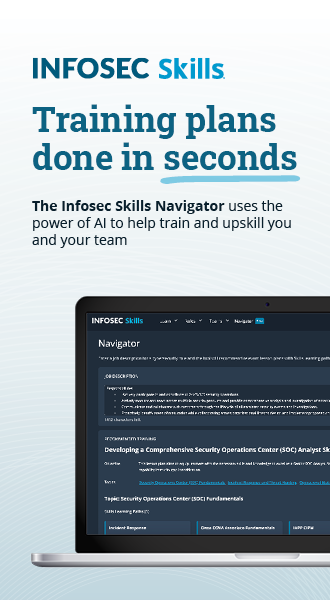How does automated penetration testing work?
In cybersecurity, penetration testing has long been the gold standard for uncovering vulnerabilities in networks, applications and systems before bad actors do. This involved skilled cybersecurity staff manually scanning and probing networks for known vulnerabilities, misconfigurations and other security flaws. However, as cybersecurity moves forward with the rest of technology, automated pentesting has become a new weapon in the fight for digital security.
FREE role-guided training plans

Let’s look at automated penetration testing, explore its impact on the cybersecurity industry and cybersecurity careers in 2024 and provide some tips on leveraging its power as a security professional.
Understanding automated penetration testing
Automated penetration testing is the practice of using specialized software to simulate cyberattacks and identify weaknesses in your systems, networks and apps. This streamlines the process of vulnerability discovery and exploitation, enabling businesses to improve their security posture more efficiently.
This differs from traditional manual penetration testing, which involves a skilled security professional meticulously probing your defenses using a combination of creativity, technical expertise and an understanding of attacker tactics. In automated testing, many of these repetitive processes can be scripted and run on a schedule, especially when looking for well-defined vulnerabilities.
But this is just the first step to streamlining penetration testing steps, and autonomous penetration testing takes the automation process even further. This next-generation approach uses artificial intelligence and machine learning to not only identify vulnerabilities but also attempt to exploit them in a controlled environment.
In addition, autonomous testing tools can adapt to changes in systems and recover from errors in the testing process. They can find patterns in historical test data and use predictive analysis to identify and address possible security issues before they happen.
The process of automated penetration testing
Just like its manual counterpart, automated penetration testing follows a structured approach to find vulnerabilities and determine the security posture of a network along with its services and resources. Here are the common stages of an automated pentest:
- Planning and scope definition: The first stage defines the boundaries of the testing environment, just as you would in manual testing. This includes identifying the specific systems, networks and applications you want to assess, along with the desired depth of testing. This allows the security professional to configure the automated tools to target the most relevant areas so that the tests are efficient and cause less disruption.
- Automated scanning and enumeration: Automated testing tools employ a variety of techniques, including vulnerability scanners, network scanners and web application scanners, to provide a detailed map of your digital landscape. These scans pinpoint potential entry points for attackers and gather information about the systems and services running on your network for further analysis.
- Vulnerability analysis: Once the scans are complete, the automated tools then sift through the mountains of data collected. The testing software leverages known vulnerability databases and cross-references found vulnerabilities to determine the severity and potential impact of each.
- Exploitation and reporting: Many automated tools take things a step further and attempt to simulate real-world attacks, exploiting identified vulnerabilities in a controlled environment. This allows you to not only understand the existence of a weakness but also gain valuable insights into how attackers might use it. Following this analysis, the tools generate detailed reports outlining their findings, complete with severity ratings and recommendations for remediation. These reports then become your roadmap to patching vulnerabilities and fortifying your defenses.
Benefits and limitations of automated penetration testing
Automated penetration testing can help you manage risk strategy effectively, determine infrastructure weaknesses and increase overall security awareness just like manual testing, but it also has some added benefits, including:
- Scalability and speed: Automated tools can scan a vast network with thousands of devices in a fraction of the time it would take a human pentester.
- Cost-effectiveness: Automated tools cost an organization much less than building and maintaining an entire team of skilled pentesters.
- Reduced human error: Even the most seasoned security professionals can make mistakes, but automated tools consistently follow established procedures.
- Comprehensive reporting: Automated tools generate detailed reports outlining their findings and provide a clear roadmap for remediation efforts.
However, automated penetration testing is not without its limitations. Here are some common issues with using an automated process:
- False positives: Automated tools can sometimes flag harmless anomalies as vulnerabilities, leading to wasted time and resources investigating non-existent threats.
- Lack of contextual understanding: "[Scanners] don't care whether this application is used in financial services or healthcare," says Ted Harrington, a well-known security expert. "The attacker does, and the defender definitely does."
- Inability to exploit complex vulnerabilities: "Advanced tactics largely cannot be automated," says Harrington. These sophisticated attacks require the ingenuity and skills of a human pentester.
Tools and technologies in automated penetration testing
When it comes to automated penetration testing, selecting the right tools is crucial for achieving optimal results. And there are a lot of tools to choose from.
The open-source community has been a driving force behind the development of many popular automated pentesting tools, including:
- Nmap: A network discovery and security auditing tool.
- Wireshark: A network protocol analyzer for network troubleshooting, analysis and communication protocol development.
- Nikto2: A web server scanner that can detect outdated software and vulnerabilities.
- Legion: A semi-automated network penetration testing framework.
- Aircrack-ng: A complete suite of tools to assess Wi-Fi network security.
- Jok3r: A tool that automates network and web security tasks.
- SQLmap: A tool that automates the process of detecting and exploiting SQL injection flaws and taking over database servers.
- CrackStation: A password-cracking tool that uses rainbow tables to decipher passwords.
- Zed Attack Proxy: A penetration testing tool for finding vulnerabilities in web applications.
- OpenSCAP: A suite of tools for maintaining the security of enterprise systems with vulnerability checking and compliance checking.
- Scapy: A Python-based interactive packet manipulation program and library for network protocols.
What should you learn next?

In addition to open-source tools, several commercial solutions are available in the market, offering advanced features, complete suites of tools and dedicated support. Popular commercial automated pentesting tools include:
- Rapid7 Metasploit: An industry standard platform for vulnerability scanning, exploit development and post-exploitation activities.
- Acunetix Web Vulnerability Scanner: A comprehensive web application scanner that crawls applications, identifies vulnerabilities and offers remediation guidance.
- Burp Suite Professional: A web application penetration testing tool suite for intercepting traffic, fuzzing for vulnerabilities and analyzing security posture.
- Core Impact: A platform for comprehensive vulnerability assessment and penetration testing, enabling simulation of multi-stage attacks and identification of critical security risks.
- Nessus Professional: A leading vulnerability scanner that goes beyond basic detection, providing detailed information about vulnerabilities, exploit code and remediation steps.
It's important to note that no single tool can address all security testing needs, which is one of the reasons there are so many to choose from. Many organizations opt for a combination of tools, each serving a specific purpose or targeting a particular area of the testing process. Organizations should regularly evaluate and update their tools to keep pace with evolving security threats and technology advancements.
Automated penetration testing and cybersecurity careers
As malicious actors continue to step up their game and organizations increasingly recognize the value of proactive security measures, the need for professionals skilled at using automated pentesting tools is growing. This has also created diversity in penetration testing careers and new job roles, including:
- Penetration testing automation engineer: Responsible for designing and implementing automated penetration testing frameworks.
- Security automation analyst: Translates the power of automated penetration testing tools into actionable insights for the security team.
- Automated penetration tester: Blueprints and conducts automated penetration testing tools and frameworks.
Earning certifications in automated penetration testing can significantly enhance your career prospects because they:
- Validate your proficiency in using automated testing tools and methodologies.
- Keep you updated on the latest automated testing tools and best practices.
- Hone your skills in automated testing.
Top penetration testing certifications that validate your skills with automated testing tools include:
- CompTIA PenTest+
- EC-Council Certified Ethical Hacker (CEH)
- Certified Penetration Tester (CPT)
- Certified Expert Penetration Tester (CEPT)
- Certified Cloud Penetration Tester (CCPT)
The future of automated penetration testing
The field of automated penetration testing is new and changing rapidly, driven by technological advancements and even more complex threats. Here's a look at what's on the horizon:
- AI and machine learning will not only be able to identify vulnerabilities but continuously learn what could happen, find zero-day exploits before hackers and adapt their testing strategies dynamically.
- Response and remediation process automation will be able to integrate penetration testing tools with security information and event management (SIEM) systems.
- Focus on business impact will be the priority as automated tools integrate with the business context and prioritize tasks based on potential financial losses or operational disruptions.
Considering these advancements, cybersecurity professionals should develop skills in automated penetration testing. Pursuing relevant certifications, like PenTest+ or Certified Ethical Hacker, will help you stand out in the job market and prove to employers that you have pentesting skills.
Infosec's Ethical Hacking Dual Certification Boot Camp prepares you to pass both the PenTest+ and Certified Ethical Hacker exams. This penetration testing boot camp will immerse you in real-world pentesting scenarios and prepare you to earn both certifications in five days.
Become a Certified Ethical Hacker, guaranteed!
Get training from anywhere to earn your Certified Ethical Hacker (CEH) Certification — backed with an Exam Pass Guarantee.![]()
Automated penetration testing FAQ
By leveraging automated penetration testing tools, we can streamline vulnerability identification, prioritize risk more effectively and fortify our defenses against cyber threats. But it's important to remember that automation is a force multiplier, not a silver bullet.
The best approach combines the speed and efficiency of automation with the critical thinking and context awareness of a skilled human pentester who's also necessary to use the automation tools effectively — a skill you can validate through certification.
What are the prerequisites for learning automated penetration testing?
Begin by learning the basics of computer networking, operating systems and programming. Then, consider enrolling in courses or certifications that focus on automated penetration testing, such as the Ethical Hacking Dual Certification Boot Camp.
How do certifications in automated penetration testing impact salary and job prospects in cybersecurity?
Earning certifications and automated penetration testing, CEH (Certified Ethical Hacker) or PenTest+, validates your skills and knowledge to potential employers. These credentials can make you a more competitive candidate and may lead to higher earning potential in cybersecurity roles that require knowledge and experience with automated testing tools.
Can automated penetration testing completely replace manual penetration testing?
No, automated testing is only meant to augment manual penetration testing. While automation excels at identifying known vulnerabilities quickly and scaling, it lacks human skills. A professional pentester can bring ingenuity, critical thinking and an understanding of context to the table, uncovering complex vulnerabilities that evade automated tools.







